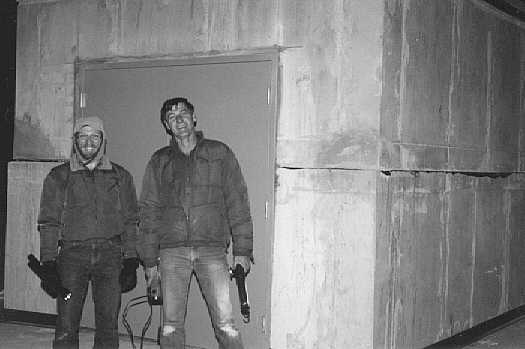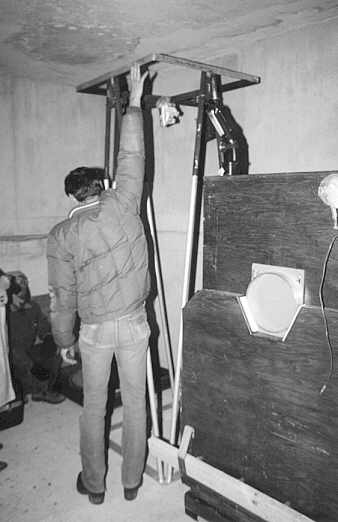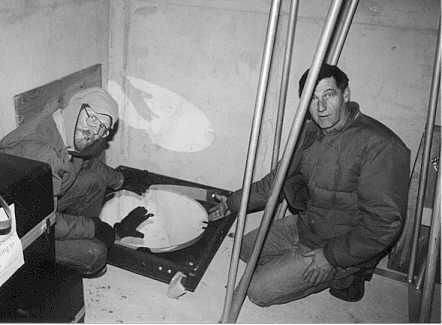

Vol. 29 Number 4 January 2000 http://physics.weber.edu/oas/oas.html
THE JANUARY MEETING
The regular monthly meeting of the Ogden Astronomical will convene at 7:30 p.m. in the Ott Planetarium on the Weber State University campus this Thursday January 13, 2000.
Following the business portion of the program, OAS members and visitors will follow Dr.
John Sohl out of the science building and cross over to the new WSU Observatory which is
about to officially open. Dr. Sohl will answer questions about the new facility and
describe the telescope hardware that is now in place, including the new 25-inch Dobsonian
reflector. Using a laser collimator, the group will watch as technicians collimate the
optical path of the 25-inch super-sky-killer.
THE PRESIDENT'S PARSEC
Greetings Earthlings:
The future is here. What I mean by that is any sci-fi novel worth its' weight in neutrinos often based it's story in the 21st century. And now we are here, (about time to start a monolith watch isn't it?). [Web Editor's note: Of course, the 21st century doesn't REALLY start until 2001, then we can start looking for monoliths!]
Following the rate of successes in space exploration of the 1960's one is surprised that we haven't mined the moon or put colonies on Mars by now. Just as surprising though is the amount of knowledge and exploration we have achieved by refining to the nth degree the conventional technology we have had for years.
The Hubble Space Telescope and mega-meter ground based telescopes with adaptive and
infra-red optics have given us unprecedented views of the universe. Advancements in
computer technology allow satellites to send us volumes of data from the far reaches of
the solar system. NASA's motto could easily be " Exploring space with our feet
planted firmly on the ground."
The information from space indicates a universe far more mysterious than even sci-fi writers 20 years ago could have imagined. And isn't that great for us telescope type of people? Our star parties are well attended simply because of the increasing mystique about our universe. The speculation game can be played by all comers. And that makes astronomy fun as well as interesting.
Yes, this future we are in now is surprising. We all thought it would be so different when we got here. But that is the future's ultimate prerogative.
Still we all need to get comfy with the future because that is where we will spend the rest of our lives. Or as Yogi Berra should have said " If you wait long enough the future will reveal itself." Or there is my own theorem concerning time. That is, there are only two dimensions of time, the past and the future. The "present" aspect of time is merely the point at which the future becomes the past and that point can never be isolated. Yet it exists because time must flow through it.... Gotta go now I am starting to hear the music from "TheTwilight Zone"
the Prez.
MINUTES
OGDEN ASTRONOMICAL SOCIETY
December 9, 1999
The regular meeting of the Ogden Astronomical Society was called to order by pres. Ron Vanderhule at 7:35 p.m.
Mini lights and calendars were distributed. Dr. Sohl reported the progress of the observatory describing certain light problems and the new 25-in Dob.
Ron introduced the evening's topic on astro. Web sites. Following the web demonstrations, The grinding compound material acquired by Ron and Wayne Sumner was discussed. Adjourned at 9:15 p.m.
Bob Tillotson, Secretary
WSU OBSERVATORY WILL HOST
A GRAND OPENING IN JANUARY
In the hope of achieving a Grand Opening with clear skies, the Weber State University Observatory has scheduled three different evenings for a public star party and introduction to the new astronomical facility.
The first (of three) planned opening night will be January 20, 2000. February 9 and 11 have also been slated with the hopes that at least one day (best if all three) will be clear. The time, for each of the events, is 7:00 p.m. and will go until at least 9:30 p.m.
Interested persons should wear warm clothing and meet at the observatory site a few minutes before 7:00 p.m.
Lunar Eclipse on the 20th
On January 20th the telescopes will be open to public use at 7:00 p.m. with views of Saturn and Jupiter. The real fun begins at 8:01 p.m. when the Moon first enters the darkest part of Earth's shadow. At 9:05 p.m. the Moon will enter totality and will be a deep red. At 10:22 p.m., the Moon will start to leave our shadow. Finally, at 11:25 p.m. the Moon will be clear of the dark central portion (the "umbra") of Earth's shadow. Still, the Moon will appear slightly shaded for about another half hour.
On the two nights in February you will be able to see the Moon much better than on the night of the eclipse. This is not because of the darkening of the Moon during the eclipse, but because of shadowing. During a Full Moon the view through a telescope is not as glorious as when it is when the Moon is in crescent phase. This is because the lunar mountains cast shadows that aid your ability to sense the lunar topography.
Weekly Star Parties
The observatory will be available for public access at 8:30 p.m. every Wednesday night during the academic year (late August through early May), weather permitting. The only exceptions are the Wednesday nights on Thanksgiving Eve and during spring break. These 8:30 p.m. Wednesday night star parties are free of charge.
Observatory Specifications
1. Main observatory building: precast concrete 12' X 20' X 10' (WxDxH) with workbenches and computer interfaces. Building has both white lights and dimmer controlled red observing lights.
2. Telescope pad: 1,040 ft2 of concrete with AC power and data links for three telescopes. Two telescopes will have permanently mounted piers for easy setup. A third telescope will have alignment marks for rapid setup also.
3. Twenty five inch diameter (12.5 foot focal length) Dobsonian telescope. This telescope has a computerized finder (Lumicon "Sky Vector II") with a data base of over 12,000 objects. The ladder that you need to climb to look into the eyepiece is 14 feet tall. This is among the largest telescopes in Utah. (Donated by Dr. Craig and LeAnn Gundy.)
4. Sixteen inch equatorial mounted and computerized Meade Starfinder telescope. (Mount donated by Dr. Jack Cook.)
5. Twelve and a half inch Dobsonian telescope.
6. Eight inch Celestron Ultima Schmidt-Cassegrain telescope. (Donated by Mr. and Mrs. Henry Novak)
7. Eight inch Celestron Classic-8 Schmidt-Cassegrain telescope.
8. Solar filter for the Celestron telescopes.
9. Six inch refracting telescope. (On loan from Dr. John Sohl.)
10. Several six inch Newtonian telescopes.
11. Four inch Unitron refracting telescope. (This scope provides breath taking views of the moon and planets.) (On loan from Dr. John Sohl.)
12. A three inch refracting telescope.
13. Two CCD cameras and adapters for film cameras.
14. A radio telescope optimized for observing Jupiter's moon Io as it interacts with Jupiter's magnetic field. (Affiliated with NASA's Radio JOVE project.)
The equipment is rolled out as needed onto the observing deck which is a concrete pad with AC power and data connections to computers inside the observatory building.
The Physics Department and the College of Science would like to welcome all of you to our new observatory. We have built this observatory specifically for public star parties and for research by our physics majors. Come join us for as many as three exciting evenings of star gazing (weather permitting) at the new Physics Department Observatory. One of the largest telescopes in Utah will be setup for your use. Especially fun will be the total lunar eclipse on the night of January 20th. On each night you will be able to see lunar craters, star clusters, galaxies, Saturn, Jupiter and more. Numerous telescopes will be setup by both the Ott Planetarium and Observatory staff and the members of the Ogden Astronomical Society.
Also see: http://physics.weber.edu/planet/observatory.html [Web editor's note: There are (or will soon be) some more images there too.]
Portions of the above were drawn from the WSU Physics web site.
RLT
On a Chilly Night In December, OAS Members Paid a Visit To
The Observatory

Shortly after the word got out about the new 25-inch Dobsonian telescope that had been donated to the university, several OAS members met with Dr. John Sohl at the observatory. Though still under construction, the form and function of this new facility and the overview of the new telescope left no doubt in their minds that a new era of astronomy science was opening at Weber State University.
OAS Treasurer and master mechanic, Doug Say, discussed the workings of the new
telescope with Dr. Sohl. They considered what refinements or changes would have to be made
in order to make the instrument student and public friendly. The size of the telescope
alone is impressive. Weighing several hundred pounds overall, making the telescope
portable is going to be a challenge in itself.

The 25-inch mirror is not presently in a traditional mirror cell. Rather, it remains in
it's original "sling" cradle that was built for it over 20 years ago by Craig
Gundy et al.

The telescope is made up basically of two main parts. The box assembly and the open frame tube section. Together, the assembled telescope stands twelve feet tall.
The mirror is in very good condition considering some periods of rough use and it's age. Some updating is going to have to be considered though before the instrument can be used easily. John and Doug are working out the details.
At the January meeting of the Ogden Astronomical Society, The 25-inch telescope will be assembled in it's operating configuration and laser testing will be done to align the optics
Photographs and text are by Bob Tillotson
Jim Seargeant's - Images
Stephen's Quintet (hereafter SQ) is a close grouping of galaxies near the constellation Pegasus. Burnhams indicates SQ is an expanding or disintegrating galaxy cluster. Ever since I glimpsed SQ through my 12" from my back deck, I've wanted to get a good image of it. (At least I think I saw it - SQ is faint but it was an exceptionally dark and clear night. I saw just a trace of nebulosity, but I could make out something of the overall structure of SQ.) On 12 Sep 99 I took a series of frames of SQ but have just now worked my processing technique to the point that I could produce a decent image.
I have two images here. One is a sky chart taken from Software Bisque's TheSky program. This shows a rectangle that frames the imaging chip and above it a small square that frames the tracking chip of the ST-7 camera. The labels show the designations and magnitudes of SQ's components. The other image is the CCD image of SQ.
To take useful CCD images of an object as faint as SQ requires a fair amount of exposure time, which in turn requires good tracking. To give the ST-7/AO-7 combination a fair chance, I flipped the camera over from the usual position so that the relatively bright, mag 9.9, star would could be seen by the tracking chip. With this tracking star, the system would give well guided exposures of 600 seconds. Even longer exposures were possible, but one of the foreground stars approaches saturation (and therefore blooming) at that time. I set the ST-7 at 2x2 binning, giving 18x18 micron pixels, to improve sensitivity; that's a reasonable pixel size with the telescope operating at f/10. I took eight separate 600 second exposures.
Using Mike Newberry's Mira software, I've finally developed high quality calibration frames. I used Mira and these frames to remove the bias, dark, and flat noise from each of the SQ images. (This is one of the real marvels of CCD imaging - being able to accurately characterize and remove noise from the imaging system.) I then tried two approaches to combining the images. The first attempt was to use Mira to median combine all eight images. This method of combining improves the signal to noise ratio (S/N) of the final image and gave a beautiful, clean image. But a faint one. The effective exposure of the final image was still 600 sec. I just couldn't juggle the image enough to yield something that would come close to printing. For the second try I median combined pairs of images to improve the S/N a bit, then added the resulting four images together. This gave an effective exposure of 2400 seconds and yielded counts of around 30000 in SQ's galaxy centers; about half of the maximum. This is the image you see here. It shows structure in some of the galaxy arms that stacks up well with many of the other SQ images that's I've seen in the internet's CCD community. There is just no way to print a "faint fuzzy" image like this in the newsletter, so I hope you will look at it in the OAS page of Weber State's Physics Dept web site.
There's much room for improvement. If eight images is good, then 16 or 32 would be better; they don't even have to be the same night. I've learned how to refine the focus and collimation of my telescope - none of the images I've made before now are really representative of the best my telescope can do. I've learned that the focus must be adjusted before each exposure because as the night cools, the telescope tube cools and changes focus. And I'm still learning how to use all the myriad tools of CCD software to improve the image's appearance.
Jim Seargeant